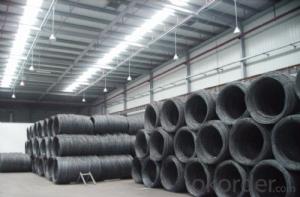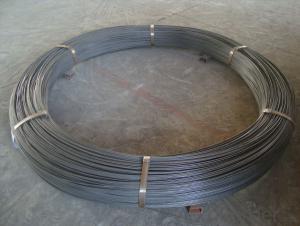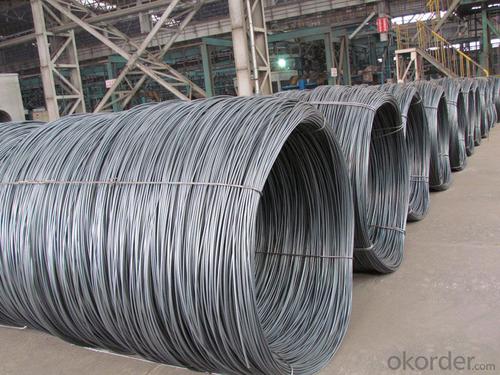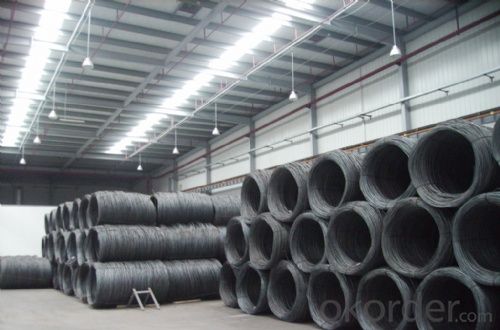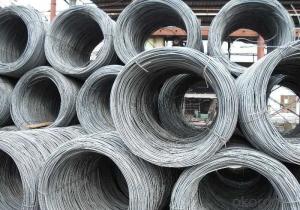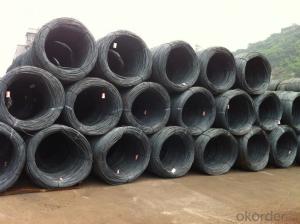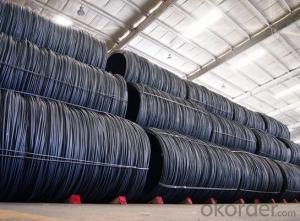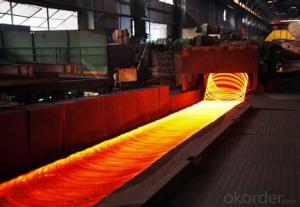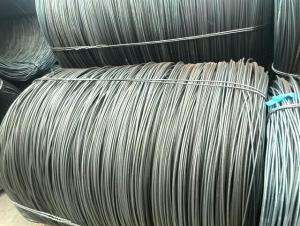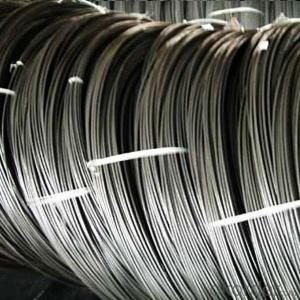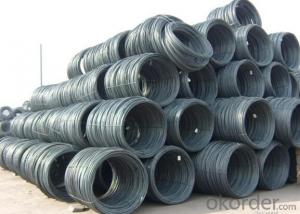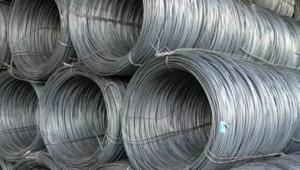High quality hot rolling wire rod(Q195-235)
- Loading Port:
- Tianjin
- Payment Terms:
- TT OR LC
- Min Order Qty:
- 1000 m.t.
- Supply Capability:
- 100000 m.t./month
OKorder Service Pledge
OKorder Financial Service
You Might Also Like
The concept of
Edit
Wire section perimeter is very small, common product specifications diameter is 5-13mm. According to the rolling mill can be divided into different high-speed wire (wire rod) and ordinary wire (S & P line) two.
2 classification
Edit
Wire usually made of ordinary carbon steel and high quality carbon steel.According to the different steel distribution directory and use the wire,including ordinary low carbon steel hot-rolled plate bar, wire rod, high quality carbon steel, Quenched and tempered threaded rods for welding wire, steel wire rope wire, piano wire wire and stainless steel wire rod etc..
Prichard steel
Prichard steel
1 ordinary low carbon steel hot-rolled plate bar (GB701-65), the ordinary low carbon steel hot-rolled plate by low carbon ordinary carbon structural steel oryield point of low carbon structural steel and rolling, is the largest amount ofwire varieties, the most widely used in the wire rod, also known as the cord.
Main application: general line is mainly used in construction of reinforced concrete structure reinforcement steel, cold drawn steel wire can also bedrawn from, as binding etc..
2 ordinary low carbon steel hot rolled wire rod without torsion cold control,(ZBH4403-88), torsion free and controlled cooling, hot rod by torsion free high speed wire rod mill rolling controlled cooling made, material and general line is the same, but without the mechanical properties of hot rolled wire rod torsion cold control, high size precision, good surface quality, high.
Main uses: no twist and controlled cooling, size precision of hot rolled wire rodis divided into A, B, C level three. A, B, C level accuracy is suitable for drawing,construction, packaging and electrode uses, B, C level accuracy is suitable for processing into bolts, screws and nuts.
3 carbon steel wire rod (GB4354-84), the high quality carbon steel wire rod is made of high-quality carbon structural steel and rolling. Is one of the larger amount of wire varieties varieties.
Main purposes: quality carbon steel wire is mainly used for manufacturingcarbon spring steel wire, oil tempered carbon spring steel wire, prestressed steel wire, high strength and high quality carbon structural steel wire,galvanized steel wire, galvanized wire rope etc..
4 high quality carbon steel hot rolled wire rod without torsion cold control,(ZBH44002-88), the high quality carbon steel hot rolled wire rod without torsion cold control, by the torsion free high speed wire rod rolling mill and rolling,controlled cooling process after rolling. Compared with the high quality carbon steel wire rods, high size precision, good surface quality, with high mechanical properties.
Main application: mainly uses the high quality carbon steel wire rod with the same. Commonly used in the manufacturing of carbon spring steel wire, oil tempered carbon spring steel wire, wire, high quality carbon structural steel wire, galvanized steel wire etc..
5 steel wire rod (YB349-64), steel wire for rope with wire is hot rolled quality carbon structural steel strips of disc.
Main purposes: quality carbon structural steel wire rope with wire rod available in 35, 40, 45, 55, 60, 65, 70, 75, 80 and 85 grades of manufacturing. Chemical composition meet the GB699 (technical requirements for steel quality carbon structural) regulations.
Torsion free control of cold and hot rolled wire rods for 6 steel wire(ZBH44004-88), torsion free control of hot and cold rolling plate and used high quality carbon structural steel with steel wire for rope rolling in no twist wire rod mill, the rolling control cooling and made. This rolling into wire rod, high size precision, good surface quality, excellent mechanical performance.
Main uses: mainly used for drawing steel wire and steel wire strand.
7 carbon welding steel wire rod (GB3429-82), carbon welding steel wire rodmade of low carbon hot rolled quality carbon structural steel made.
Main uses: mainly used in the manufacture of manual electric arc weldingelectrode.
8 carbon welding rod steel torsion free and controlled cooling, hot rod(ZBH44005-88), carbon welding rod steel torsion free and controlled cooling,hot rod is blocked in a twisted wire rod rolling, and rolling control cooling and made. The high size precision, good surface quality, superior performance, is a kind of high quality welding steel wire rod.
Main uses: mainly used for carbon steel hot rolled strip steel core discmanufacturing welded with the medicine skin.
9 structural alloy steel hot rolled wire coil (GB3077-82), alloy structure steelhot rolled wire rods by alloy structure steel as material and rolling. Alloystructural steel has a total of 26 Steel Group, 78 steel grades. Each productionplant according to any requirements and different use of selected grades for production.
Main uses: mainly used for structural alloy hot rolled wire drawing steel wire,metal products and structures.
10 carbon tool steel hot rolled wire coil (GB1298-86), carbon tool steel by high quality or high quality high carbon steel and rolling. The processing performance and wear-resisting performance is good, the price is cheap.
Main uses: mainly used for drawing steel ratio and manufacturing tools etc..
11 alloy tool steel hot rolled wire rod (GB1299-77)
Alloy tool steel is in the matrix of the carbon tool steel adding chromium,tungsten, molybdenum, vanadium, silicon, manganese, nickel and cobalt alloyelements and tempered steel. Compared with the carbon tool steel. It has good hardenability and cracking tendency of small, wear resistance and high heat resistance characteristics of heat treatment. Alloy tool steel, alloy tool steel hot rolled wire rod is composed of 5 steel group of 33 steel as the material and rolling. Are produced by the unit of the Dalian steel plant, Benxi steel andShaanxi steel etc..
Main purpose: is used for making the measuring tools, tools and cold and hot working die, shock resistant tool etc..
12 hot rolled spring steel wire rod (GB1222-84)
Spring steel is used in steel manufacturing springs or elastic element. The spring and the elastic element is mainly the use of the elastic deformationenergy absorption and storage, to mitigate the vibration and impact of theparts or do some action for the purpose of. Because it is periodic alternating inshock, vibration or long-term uniform stress conditions, so the requirements of spring steel has a high yield strength, especially to a higher ratio of yield strength (yield strength and tensile strength ratio) and the fatigue strength ofhigh elasticity
- Q: How are steel wire rods used in the manufacturing of wire baskets for organizing items?
- Steel wire rods are used in the manufacturing of wire baskets for organizing items as they serve as the primary material for constructing the framework and structure of the basket. The rods are bent, shaped, and welded together to create the desired size and design of the basket. This sturdy and durable wire framework provides stability and strength to the basket, allowing it to hold and organize items efficiently.
- Q: How is steel wire rod used in the production of wire mesh sieves?
- Steel wire rod is an essential component in the production of wire mesh sieves. It serves as the raw material from which the wire mesh is created. The steel wire rod is initially subjected to a series of processes, including drawing, annealing, and coating, to enhance its strength and durability. Once the steel wire rod has been prepared, it is then fed into a wire drawing machine, which reduces its diameter to the desired size. This process ensures that the wire is of a uniform thickness and smooth surface, which is crucial for the subsequent manufacturing steps. The drawn wire is then annealed, a heat treatment process that improves its flexibility and removes any residual stresses. This makes the wire easier to work with and less prone to breakage during the production of wire mesh sieves. After annealing, the wire is coated with a protective layer, typically zinc or PVC, to enhance its resistance to corrosion. This coating acts as a barrier, preventing the wire from coming into direct contact with corrosive substances, thereby increasing its lifespan and maintaining its structural integrity. The coated wire is then woven or welded to create the wire mesh sieve. The weaving process involves interlacing the wires together in a crisscross pattern, creating a grid-like structure. On the other hand, welding involves fusing the wires at their intersections using heat and pressure. The resulting wire mesh sieve is a versatile and reliable tool used in various industries. It is commonly employed for particle size analysis, filtration, and sorting applications. The strength and durability of the steel wire rod used in its production ensure that the wire mesh sieve can withstand high pressures and abrasion, making it suitable for demanding environments. In summary, steel wire rod is an integral part of the manufacturing process for wire mesh sieves. It undergoes drawing, annealing, and coating to enhance its properties, and is then woven or welded to create the final product. The resulting wire mesh sieve is a robust and versatile tool used in a wide range of industries for particle analysis and filtration purposes.
- Q: How is steel wire rod stored and handled to prevent corrosion?
- Steel wire rod is stored and handled in a way that prevents corrosion by implementing various protective measures. Firstly, it is stored in a dry, well-ventilated area to minimize exposure to moisture. Additionally, the wire rod is often coated with a rust-resistant material, such as zinc or a special anti-corrosion coating, to provide an extra layer of protection. Furthermore, proper handling techniques are employed to prevent any damage to the protective coating, ensuring that the wire rod remains safeguarded against corrosion.
- Q: How are steel wire rods used in the manufacturing of screws and bolts?
- Screws and bolts rely heavily on steel wire rods as a fundamental component in their production. These wire rods are utilized as the primary raw material from which screws and bolts are derived. To initiate the manufacturing process, careful selection of high-quality steel wire rods is conducted to ensure that they possess the necessary strength and durability characteristics required for screws and bolts. These wire rods are then subjected to a range of procedures, such as heating, rolling, and drawing, in order to transform them into thinner wire forms with precise dimensions. The drawn wire then undergoes a series of additional steps to create the specific shape and thread pattern essential for screws and bolts. For example, the wire may be cut into shorter lengths, and the ends are typically chamfered or beveled to facilitate easier insertion into materials. Once the wire has been shaped and prepared, it progresses to the threading process. This involves the creation of helical ridges on the wire, which will ultimately enable the screw or bolt to securely fasten objects together. The threading can be accomplished using various methods, such as rolling, cutting, or grinding, depending on the desired type of screw or bolt. Following the threading process, the wire is cut into individual pieces of the desired length, and the heads of screws or bolts are formed using diverse techniques, including cold forging or hot forging. Cold forging entails shaping the head by applying pressure to the cold wire, whereas hot forging involves heating the wire before shaping it. After the formation of the heads, the screws and bolts undergo additional procedures, such as heat treatment, surface coating, and quality control inspections. These measures guarantee that the final product meets the required standards for strength, corrosion resistance, and dimensional accuracy. In essence, steel wire rods play an indispensable role in the manufacturing of screws and bolts. They function as the initial material and undergo several processes, encompassing shaping, threading, and forming, to ultimately yield high-quality screws and bolts that find extensive use in numerous industries.
- Q: What are the different welding processes used for steel wire rod?
- There are several different welding processes used for steel wire rod, including MIG welding (Metal Inert Gas), TIG welding (Tungsten Inert Gas), and resistance welding. Each of these processes has its own advantages and is suitable for different applications. MIG welding is commonly used for high-speed production and can handle thicker materials, while TIG welding provides precise and clean welds, making it suitable for delicate and intricate work. Resistance welding, on the other hand, uses electrical resistance to join the wire rod and is often used for spot welding or seam welding applications.
- Q: What are the common applications of high-strength steel wire rod?
- High-strength steel wire rods are commonly used in a variety of applications, including construction, automotive, aerospace, and manufacturing industries. They are often used for reinforcement in concrete structures, such as bridges and buildings, due to their superior strength and durability. In the automotive industry, high-strength steel wire rods are utilized for the production of suspension systems, seat frames, and safety components. They are also essential in the aerospace sector for manufacturing aircraft components and engines. Additionally, high-strength steel wire rods find applications in manufacturing processes, such as wire mesh, springs, and cables, due to their ability to withstand high stress and resist deformation.
- Q: How is steel wire rod used in the production of wire ropes for marine applications?
- Steel wire rod is an essential component in the production of wire ropes for marine applications. Wire ropes are widely used in the marine industry for various purposes such as mooring, towing, lifting, and rigging operations. Steel wire rod, which is typically made from high carbon steel, serves as the raw material for manufacturing wire ropes. The wire rod undergoes a series of processes to transform it into the final product. Firstly, the wire rod is drawn through a series of dies to reduce its diameter and increase its length. This process is known as wire drawing and is performed to achieve the desired size and strength of the wire rope. The drawn wire is then coated with a lubricant to enhance its corrosion resistance and reduce friction during the subsequent processes. Next, the lubricated wire is twisted together with other wires to form strands. These strands are then helically laid around a core wire to create the wire rope. The core wire can be made of steel or a synthetic material depending on the specific application requirements. The strength and durability of the wire rope depend on the quality of the steel wire rod used. The high carbon content in the wire rod provides the necessary strength and load-bearing capacity required for marine applications. Additionally, the wire rod's resistance to corrosion is crucial in ensuring the longevity and reliability of the wire rope in harsh marine environments. Furthermore, the mechanical properties of the wire rod, such as tensile strength and ductility, are crucial factors in determining the performance of the wire rope. These properties enable the wire rope to withstand heavy loads, resist deformation, and endure the dynamic forces encountered during marine operations. In conclusion, steel wire rod plays a critical role in the production of wire ropes for marine applications. Its high strength, corrosion resistance, and mechanical properties make it an ideal raw material for manufacturing wire ropes that can withstand the demanding conditions of the marine industry.
- Q: How is steel wire rod used in the production of wire mesh for food processing?
- Wire mesh for food processing relies heavily on steel wire rod as a vital ingredient. Also known as wire cloth or wire fabric, this versatile material finds applications across various industries, including food processing. Its primary functions involve sieving, filtering, and separating solids and liquids during the production and processing of food products. Steel wire rod acts as the raw material for wire mesh manufacturing. It takes the form of lengthy, cylindrical steel pieces coiled together. Selection of the wire rod depends on desired qualities like strength, durability, and resistance to corrosion, which are essential for its application in the food processing sector. To produce wire mesh for food processing, the steel wire rod undergoes a series of manufacturing processes. Initially, the wire rod is drawn through a series of dies, reducing its diameter and achieving the desired wire thickness. This process, known as wire drawing, enhances the wire's ductility and flexibility. Once the wire attains the desired thickness, it is either woven or welded to form wire mesh. Weaving involves interlacing the wires vertically and horizontally, creating a grid-like pattern. This pattern determines the size of the openings in the wire mesh, facilitating specific particle or liquid filtration. In food processing, stainless steel wire rod is typically used to manufacture wire mesh. Stainless steel is favored due to its high resistance to corrosion, ease of cleaning, and hygienic properties. These qualities make it suitable for applications where food safety and cleanliness are of utmost importance. Wire mesh produced from steel wire rod finds numerous applications in the food processing industry. It is commonly employed as sieves or screens in food processing equipment, such as vibrating sifters or centrifugal separators, to separate or classify particles of different sizes. It can also serve as a conveyor belt or conveyor screen, allowing for the smooth transportation of food products through various processing stages. Moreover, wire mesh can function as protective barriers or covers for food processing machinery, preventing contamination and ensuring worker safety. It can also be used as fencing or enclosures for storage areas or production facilities, creating a secure and controlled environment for food processing operations. All in all, steel wire rod plays a pivotal role in wire mesh production for food processing. Its strength, durability, and resistance to corrosion make it an ideal material for manufacturing wire mesh that meets the stringent requirements of the food processing industry.
- Q: How are steel wire rods used in the production of wire ropes for heavy lifting?
- The strength, durability, and versatility of steel wire rods are crucial in the production of wire ropes for heavy lifting. Wire ropes are essential for safe and effective heavy lifting because they offer the required strength and support. To produce wire ropes, steel wire rods are used as the raw material. These rods are typically made of high-quality, high-carbon steel, which possesses excellent tensile strength and resistance to wear and tear. To ensure the longevity and reliability of the wire ropes, the rods are first cleaned and coated to prevent corrosion. The manufacturing process begins by drawing the wire rods through a series of dies. This reduces their diameter and increases their length, thereby increasing their tensile strength. The drawn wires are then twisted together in a specific pattern to form strands. These strands are further twisted together in a helical pattern around a core, which can be made of hemp, steel, or synthetic materials based on the specific application and load requirements. This forms the final wire rope. The utilization of steel wire rods in wire rope production guarantees that the resulting wire ropes possess the necessary strength and durability for heavy lifting operations. They can endure immense tension and bear heavy loads without deforming or breaking. This is particularly important in industries like construction, mining, and maritime, where heavy lifting operations are common. Additionally, steel wire rods offer excellent resistance to abrasion, corrosion, and fatigue. This makes wire ropes suitable for harsh environments and prolonged use. These properties are crucial for heavy lifting applications, as the wire ropes need to maintain their integrity and reliability even under extreme conditions. In conclusion, steel wire rods play a vital role in the production of wire ropes for heavy lifting. They provide the required strength, durability, and versatility to ensure the safety and efficiency of heavy lifting operations across various industries.
- Q: What are the common industry developments for steel wire rod?
- Some common industry developments for steel wire rod include advancements in production technology to improve efficiency and reduce costs, increasing focus on sustainability and environmental impact, and the development of new and improved alloys for enhanced strength and performance. Additionally, there is a growing trend towards automation and digitalization in wire rod manufacturing processes to optimize operations and ensure consistent quality.
Send your message to us
High quality hot rolling wire rod(Q195-235)
- Loading Port:
- Tianjin
- Payment Terms:
- TT OR LC
- Min Order Qty:
- 1000 m.t.
- Supply Capability:
- 100000 m.t./month
OKorder Service Pledge
OKorder Financial Service
Similar products
Hot products
Hot Searches
Related keywords

